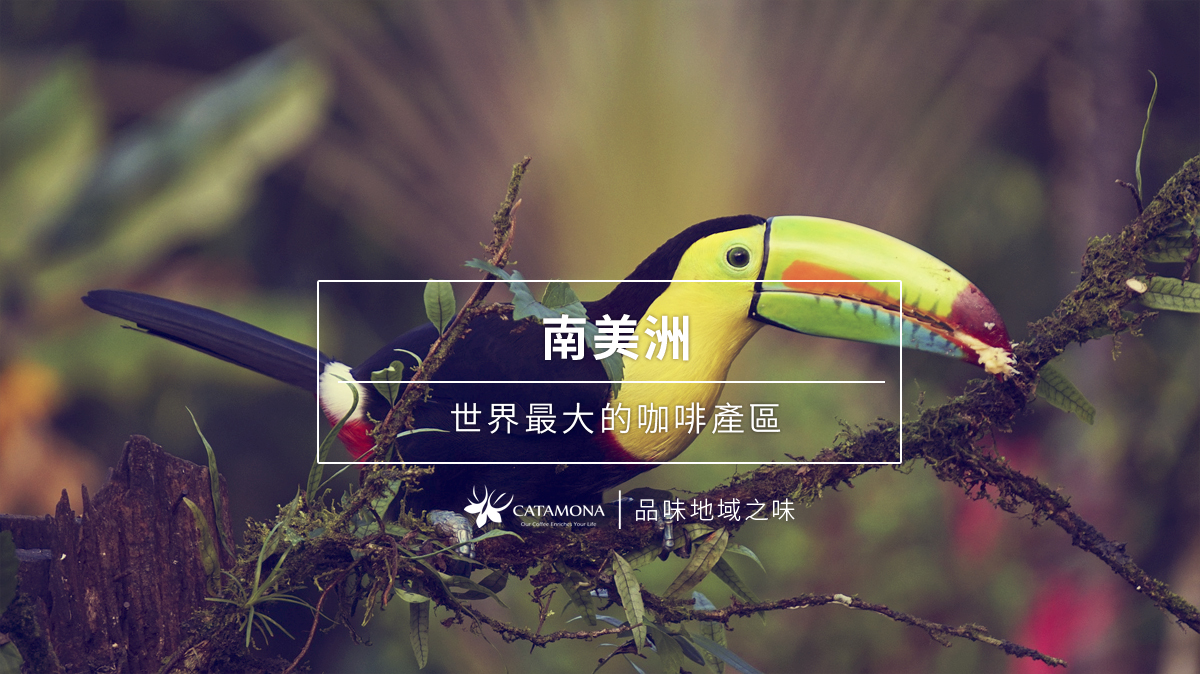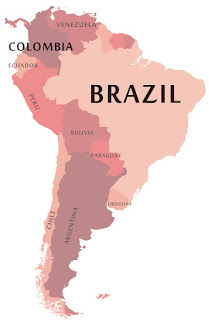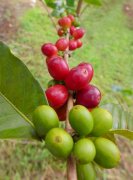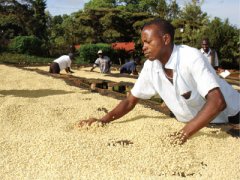Taste region │ South America ─, the largest coffee producing region in the world

For professional baristas, please follow the coffee workshop (Wechat official account cafe_style)
Do you know? South America is the largest coffee producing area in the world.
While people focus on production, in fact, there are more environmental issues to pay attention to.
The total output of the top in the world
When it comes to the leading producing area of the coffee industry, there is no doubt that it is South America and Brazil. Its coffee production accounts for about 1/3 of the world's total output, with an average annual export volume of 2m-30m bags of 60 kg coffee beans. It is not only the most extensive country in South America, but also the world leader in output. Also in the Golden Coffee Belt, South America has ─ Colombia, the second largest coffee exporter in the world. Although Colombia produces more than twice as much as Brazil, it still accounts for about 15% of global production, and the quality is stable because it produces only Arabica coffee beans.
In terms of flavor, generally speaking, coffee beans in South America are neutral and the flavor is more supple. Brazilian coffee tastes smooth and mild, can be tasted individually, and is also suitable for adding milk to make fancy coffee such as latte and cappuccino, which is widely used for blending. In contrast, Colombian coffee has a strong aroma and moderate bitterness. It is not only recommended to drink as a single product, but also commonly used in coffee blending to increase the sweetness of coffee and neutralize the bitterness of other coffees. As a result, South American coffee is a special favorite flavor of Asians.

Brazilian Coffee Association and CoE Competition
In 1991, Brazil established the Coffee Association to improve the quality of extremely hard beans comparable to that at high altitude, and with the assistance of the American Fine Coffee Association (SCAA), held the first Brazilian extraordinary Cup Coffee Competition (Cup of Excellence) in 1999. After years of witness and guidance by international cup testers, the flavor gradually gained public recognition, and also broke away from the stereotype of Brazilian coffee without fine products.
Have you ever tried Brazilian coffee? Brazilians are addicted to caffeine and regard coffee as their energy source. The so-called Brazilian coffee is to use a small porcelain cup to pour a very strong cup of coffee, coupled with the refined sugar produced in Brazil, to drink smoothly and delicious. Pouring hot milk into coffee is a traditional Brazilian breakfast drink called morning coffee (Cafedamanha). There is a folk song in Brazil that reads: "Coffee must be as black as the devil, as hot as hell, as pure as an angel, and as sweet as love." For most Brazilians, drinking coffee is a habit, a pleasure and a lifelong relationship.
The status of coffee industry in Brazil
Under the halo of global champion production, Brazil is also the second largest coffee consumer in the world after the United States. In 2009, based on the country's population, the average annual coffee consumption per person was about 5.8 kg, ranking 14th in the world. In 2014, Brazil's persistent drought was the worst abnormal climate since the Black Frost phenomenon in 1975, causing more than 70 per cent of Brazilian coffee production to fail, breaking the record for the first two consecutive years of decline in the past 20 years. Earlier, it was even said that once the market heard that Brazil was prone to frost, the international coffee futures price would rise sharply by 10% within one minute, indicating Brazil's prominent position in the world coffee industry, not to mention the continuous drought in recent years. How much a heavy blow and impact on the coffee industry as a whole.
Note 1 "Black ice": when the weather humidity is not enough to frost, the black ice phenomenon is called when the temperature is too low to blacken the crops and freeze to death.
The abnormal global climate has caused a poor harvest of coffee in Brazil and other producing areas, while the sharp drop in Brazilian coffee production is directly reflected in the futures price of coffee. By mid-2014, coffee futures had risen 77% to about $1.95 a pound (see left-hand chart). This shows Brazil's impact on the coffee supply chain.
Looking at the issue of climate change from South America
The International Coffee Organization (ICO) warns that the damage to coffee shrubs caused by extremely high temperatures may last for many years, and the impact on overall coffee bean production is difficult to estimate; even if production in Colombia and other Central American countries affected by leaf rust (Leaf Rust) [Note 2] has gradually recovered, it is not enough to fill the huge gap in Brazil, and coffee bean production forecasts for 2015 and 2016 are not optimistic. Some analysts believe that when supply falls short of demand, the price of coffee beans may even rise to $3 a pound.
Under the factors of climate change, more and more non-governmental organizations are committed to the sustainable management of resources, among which UTZ certification organizations are not only invested in the coffee industry, including cocoa and tea can be certified by UTZ, to ensure that they can be grown in a sustainable way, but also provide local farmers with better resources and lives. The UTZ certification organization has more than 82,000 coffee farms worldwide with more than four years of UTZ certification, of which 33% are located in Brazil.
After the rise of emerging markets in Asia, the demand for coffee is growing; at the same time, with the outbreak of abnormal climate, insect pests and leaf rust, there is a huge gap between supply and demand in the world coffee market. It also took the Colombian government and non-governmental sustainable farming organizations four years to improve local coffee bean production. The counterattack of nature can cause great damage in an instant, but the process of restoration is always long and arduous, so Hivos, an international development organization, strongly urges every link in the industry to pay more attention to the issue of resource sustainability, otherwise areas suitable for large-scale cultivation at this stage will face a crisis of sharp reduction in production caused by climate change before 2020.
Important Notice :
前街咖啡 FrontStreet Coffee has moved to new addredd:
FrontStreet Coffee Address: 315,Donghua East Road,GuangZhou
Tel:020 38364473
- Prev

A brief talk on the Regional Flavor of Coffee in Central America-- Panama, which is famous for its rosy summer
For the exchange of professional baristas, please pay attention to the coffee workshop (Wechat official account cafe_style) the Boguit producing area (Boquete) is the oldest and most famous coffee producing area in Panama, located on the eastern side of the Baru volcano, on a plateau about 10002000 meters above sea level. The ecological environment of the Bogut area is intact and the rainfall is abundant. The good planting environment makes the coffee in the Bogut area have a unique aroma.
- Next

Savor the regional │ coffee from here-Ethiopia
The exchange of professional baristas please follow the coffee workshop (Wechat official account cafe_style) 16th century Lebanese scholar Faustus Nairous Barlesius wrote in his book the Sleepless Monastery that the origin of coffee was discovered by shepherds living in the Ethiopian highlands in the sixth century. Coffee starts here in Ethiopia and Africa, known as the birthplace of coffee.
Related
- Does Rose Summer choose Blue, Green or Red? Detailed explanation of Rose Summer Coffee plots and Classification in Panamanian Jade Manor
- What is the difference between the origin, producing area, processing plant, cooperative and manor of coffee beans?
- How fine does the espresso powder fit? how to grind the espresso?
- Sca coffee roasting degree color card coffee roasting degree 8 roasting color values what do you mean?
- The practice of lattes: how to make lattes at home
- Introduction to Indonesian Fine Coffee beans-- Java Coffee producing area of Indonesian Arabica Coffee
- How much will the flavor of light and medium roasted rose summer be expressed? What baking level is rose summer suitable for?
- Introduction to the characteristics of washing, sun-drying or wet-planing coffee commonly used in Mantenin, Indonesia
- Price characteristics of Arabica Coffee Bean Starbucks introduction to Manning Coffee Bean Taste producing area Variety Manor
- What is the authentic Yega flavor? What are the flavor characteristics of the really excellent Yejasuffi coffee beans?

